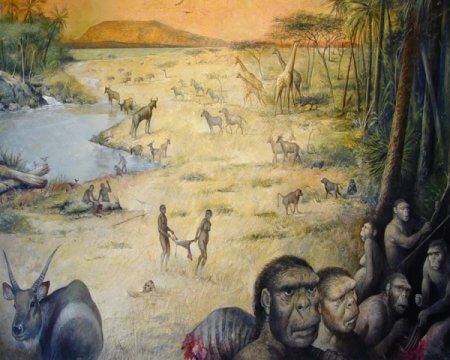"Life was tense due to the continuous competition with the predators for their food" said the lead researcher in a group of scientists who managed to assemble a living environment of the primitive man in Tanzania in East Africa

"Our ancient ancestors who looked like a hybrid of apes and modern humans had access to food, water and shelter at an excavated site in Oldubai, Tanzania. They even had a lot of stone tools with sharp edges," says Gail Ashley, a professor in the Department of Earth and Planetary Sciences at Rutgers University.
But "it was a hard life", she said. "Life was tense due to the continuous competition with the predators for their food."
Over the course of many years of work, Ashley and other researchers carefully recreated a life-scale landscape of a prehistoric human habitat using plants and other finds excavated at the site. The study was recently published in the journal PNAS.
"Reconstructing the living environment will help paleontologists develop ideas and models of what early humans looked like, how they lived, how they obtained food, especially proteins, what they ate and drank, as well as their behavior," says Ashley.
The site was discovered in 1959 by the famous paleontologist Marie Leakey. Thousands of animal bones and stone tools were found at the site. During painstaking excavations over the past decade, Ashley and other scientists and students were able to collect countless soil samples and study them using carbon isotope analysis. It turns out that there was a spring of living water in the area not far from the place where the human remains and their stone tools were found. Ashley says.
"We were able to map the types of plants that were in this area and that were useful to humans. This has never been done before. Mapping and soil analysis in one geological area and another where the bones of two different hominin species were found. "
The species were Paranthropus boisei which was solid but had a small brain, and Homo habilis - the longer boned one which also had a large brain and which was part of the evolutionary tree that led to man. The height of the individuals of both sexes ranged from 1.30 to 1.60 meters and their lifespan ranged from thirty to forty years.
During the research, the researchers learned that the Mitzala grove contained dates and acacia trees. They don't think the hominins camped there but based on the large concentration of bones, they may have obtained the food elsewhere and ate the meat in the forest because it was safe.
The surprising twist in the plot came in the form of a layer of volcanic ash that covered the site and preserved the bones and organic matter, said Ashley, who has been researching the site since 1994. "Think of an event like the volcanic eruption that destroyed Pompeii." Ashley commented and added that the volcano was about 15 kilometers away from the site. The eruption caused a lot of ash to be emitted and it completely covered the place like a blanket. At the site, the scientists found thousands of bones of animals such as giraffes, elephants and wild animals, most of them from the antelope family. It is possible that the hominids killed the animals for their meat or that they fed on leftover meat where they competed with lions, tigers and hyenas that posed a threat to the safety of the hominids, says Ashley.
Paleontologists began to formulate insights as to whether the hominids actually hunted animals as a source of meat or perhaps they were scavengers who were satisfied with the remains of the meat of an animal killed by a lion or hyena. "The issue of eating meat is important to current research on hominins," she said. "We know that the increase in brain volume in human evolution was likely a product of protein availability."
The food of the hominins also included ferns that grew in the swamp area as well as crabs, snails and other aquatic creatures. The scientists estimate that the hominids used the site for a long time - perhaps tens or hundreds of years. "We do not believe that they lived there" she said. "We believe that they simply took advantage of the water source that was nearby."
to the notice of the researchers
More of the topic in Hayadan:

4 תגובות
A beautiful fairy tale
Lucy was of the genus Australopithecus afarensis
- The Paranthropus boise is better known as Australopithecus
That is, the southern monkey, its inclusion in the genus Homo is not agreed upon at all...
- The volcano is the Oldunyo-Ngai (Mountain of God) which is still active today,
The comparison to the eruption that destroyed Pompeii is wrong because Pompeii was
covered lava and rocks while the Oldunyo-Ngai emitted clouds of ash and dust,
- It is accepted by paleontologists that the meat source of our ancestors was mainly carcasses,
Even today there are groups of "hunters" who drive predators from their prey
and "robber" the meat of the carcass.
And today is a picnic?